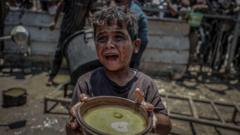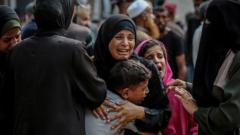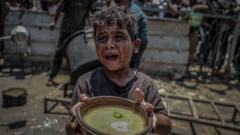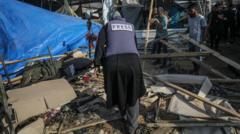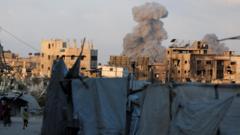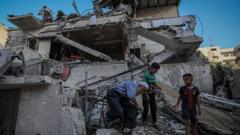The Integrated Food Security Phase Classification has reported that man-made conditions, heavily influenced by Israeli policies, have created a famine in Gaza affecting a quarter of the population. Aid organizations accuse Israel of systematically obstructing food access, while the Israeli government disputes the findings, claiming manipulation by Hamas.
Gaza's Dire Famine: A Consequence of Human Decisions
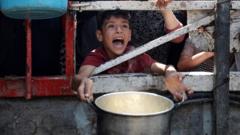
Gaza's Dire Famine: A Consequence of Human Decisions
A UN report reveals that ongoing policies by Israel have led to a catastrophic famine in Gaza, affecting hundreds of thousands.
How famine conditions developed in Gaza is a critical question, as a recent report highlights the devastating effects of Israeli policies on the region’s food security. The Integrated Food Security Phase Classification (IPC), endorsed by the United Nations, has revealed that approximately 500,000 people – or 25% of Gaza's population – are currently facing famine, a situation deemed "entirely man-made." This alarming conclusion stems from accusations directed at Israel for the systematic obstruction of essential food supplies entering Gaza amid ongoing conflicts.
The IPC’s detailed assessment articulates a severe humanitarian crisis, emphasizing dire conditions such as starvation, malnutrition, and high mortality rates linked to inadequate food access. The findings identify three compelling indicators of famine: one in five households experiences an extreme food shortage, approximately one in three children suffers from acute malnutrition, and an estimated two in every 10,000 individuals die daily due to starvation or related health issues.
Despite these devastating statistics, Israeli Prime Minister Benjamin Netanyahu has repudiated claims of famine, asserting that any hunger present is attributed to the behaviors of aid organizations and Hamas. He argues that ample aid sits at Gaza's borders, awaiting collection by international entities, rather than accessible by those in dire need.
Complicating matters further, the humanitarian landscape in Gaza has sharply deteriorated since the onset of the conflict. Restrictions imposed by Israel have intensified since the outbreak of hostilities in October 2023. Starting in March 2025, a profound blockade was placed on the entry of goods, culminating in a humanitarian crisis unseen in prior years. In response to external pressures, Israel finally increased the volume of aid trucks allowed into Gaza, though current provision levels remain critically inadequate.
Reports indicate that efforts to distribute assistance have become perilous for the residents of Gaza. Humanitarian agencies have recorded nearly 1,000 deaths, primarily caused by violence in proximity to food distribution points overseen by a new American organization. This has shifted the distribution mechanism away from a previously operational UN system, resulting in alarming rates of violence and fatalities amongst those seeking aid.
In recent statements, the Israeli government has rejected IPC findings, labeling them as distorted and biased towards Hamas narratives. It contests the methodology used to establish the famine criteria, asserting that the report disregards essential statistical benchmarks for mortality. Nevertheless, various international entities, including the United Nations, have condemned the treatment of Gazans as a violation of humanitarian norms and international law, advocating for immediate and unrestricted aid access.
Amid escalating tensions, Israel's recent military operations in Gaza City aim to quell Hamas's influence, with dire predictions that such a campaign will further aggravate the plight of civilians trapped in famine-stricken areas. Several humanitarian organizations have expressed grave concerns regarding the potential humanitarian fallout of these operations, especially for vulnerable populations unable to evacuate.
As the conflict continues, the entangled issues of governance, responsibility, and accessibility to aid remain critical in evaluating the humanitarian crisis currently unfolding in Gaza.


